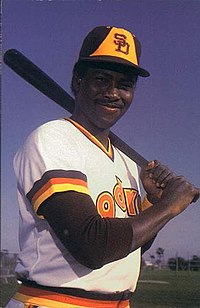
Back توني غوين Arabic تونى جوين ARZ Tony Gwynn German Tony Gwynn Spanish Tony Gwynn French Tony Gwynn Galician Tony Gwynn Italian トニー・グウィン Japanese 토니 그윈 Korean Tony Gwynn Polish
| Tony Gwynn | |
|---|---|
 Gwynn with the San Diego Padres in 1983 | |
| Right fielder | |
| Born: May 9, 1960 Los Angeles, California, U.S. | |
| Died: June 16, 2014 (aged 54) Poway, California, U.S. | |
Batted: Left Threw: Left | |
| MLB debut | |
| July 19, 1982, for the San Diego Padres | |
| Last MLB appearance | |
| October 7, 2001, for the San Diego Padres | |
| MLB statistics | |
| Batting average | .338 |
| Hits | 3,141 |
| Home runs | 135 |
| Runs batted in | 1,138 |
| Stats at Baseball Reference | |
| Teams | |
| Career highlights and awards | |
| |
| Member of the National | |
| Induction | 2007 |
| Vote | 97.6% (first ballot) |
Anthony Keith Gwynn Sr. (May 9, 1960 – June 16, 2014), nicknamed "Mr. Padre", was an American professional baseball right fielder, who played 20 seasons (1982–2001) in Major League Baseball (MLB) for the San Diego Padres. The left-handed hitting Gwynn won eight batting titles in his career, which is tied for the most in National League (NL) history. He was a 15-time All-Star and won seven Silver Slugger Awards and five Gold Glove Awards. Gwynn stayed with the Padres his entire career, and played in the only two World Series appearances in San Diego franchise history. Having hit over .300 for 19 straight seasons, Gwynn retired with a .338 career batting average, the highest mark since Ted Williams retired in 1960. He was inducted into the Baseball Hall of Fame in 2007 in his first year of eligibility, and is widely considered the best pure hitter of his generation.[1][2]
Gwynn attended San Diego State University (SDSU), where he played both college baseball and basketball for the Aztecs. He was an all-conference player in both sports in the Western Athletic Conference (WAC), and was also honored as an All-American in baseball. Gwynn was selected by the Padres in the third round of the 1981 MLB draft as the 58th overall pick. He made his major-league debut the next year and won his first batting title in 1984, when San Diego advanced to its first-ever World Series. Gwynn was a poor fielder in college and the minor leagues, but improved over time and received his first Gold Glove in 1986. The next year, he won the first of three consecutive batting titles. From 1990 to 1994, Gwynn endured four injury-shortened seasons, then had four straight batting titles starting in 1994, when he batted a career-high .394 in a strike-shortened season. Gwynn played in his second World Series in 1998 and reached the 3,000-hit milestone the following year. He played two more seasons, hampered by injuries in both, and retired after the 2001 season with 3,141 career hits.
A contact hitter, Gwynn frequently hit the ball to the opposite field. After first meeting Hall of Famer Ted Williams in 1992, Gwynn modified his hitting approach and became more adept at pulling the ball and using the entire field, as well as hitting for more power. In his early career years, he was also a threat to steal bases. In an era before MLB teams used video for scouting, Gwynn pioneered the practice of recording and studying video to improve his hitting, for which he received the nickname "Captain Video". Widely considered the greatest player in Padres history, Gwynn regularly accepted less money to remain with the small-market team; he became a civic icon for the city of San Diego.
During his later playing years and throughout retirement, Gwynn was an outspoken critic of performance-enhancing drugs in baseball. After he retired from playing, the Padres retired his No. 19 in 2004. Gwynn became the head baseball coach at his alma mater university and also spent time as a baseball analyst. Gwynn developed a decades-long addiction to smokeless tobacco as a young adult, and was diagnosed with salivary gland cancer in 2010; Gwynn died of the cancer in 2014 at the age of 54. His death increased awareness regarding tobacco usage in MLB, leading to the 2016 league-wide ban on the substance for new players.
- ^ Cite error: The named reference
jenkins_06152014was invoked but never defined (see the help page). - ^ Schell, Michael J. "Tony Gwynn: Meeting Baseball's Best Hitter". Society for American Baseball Research. Retrieved January 8, 2025.